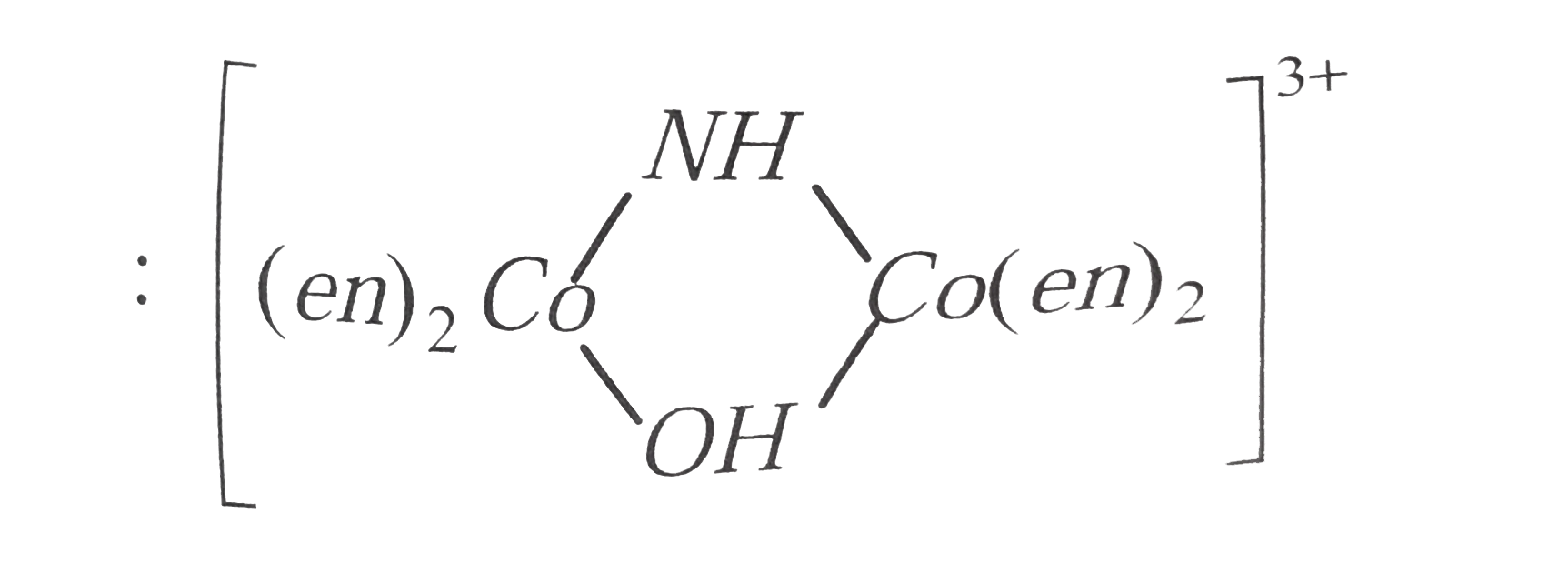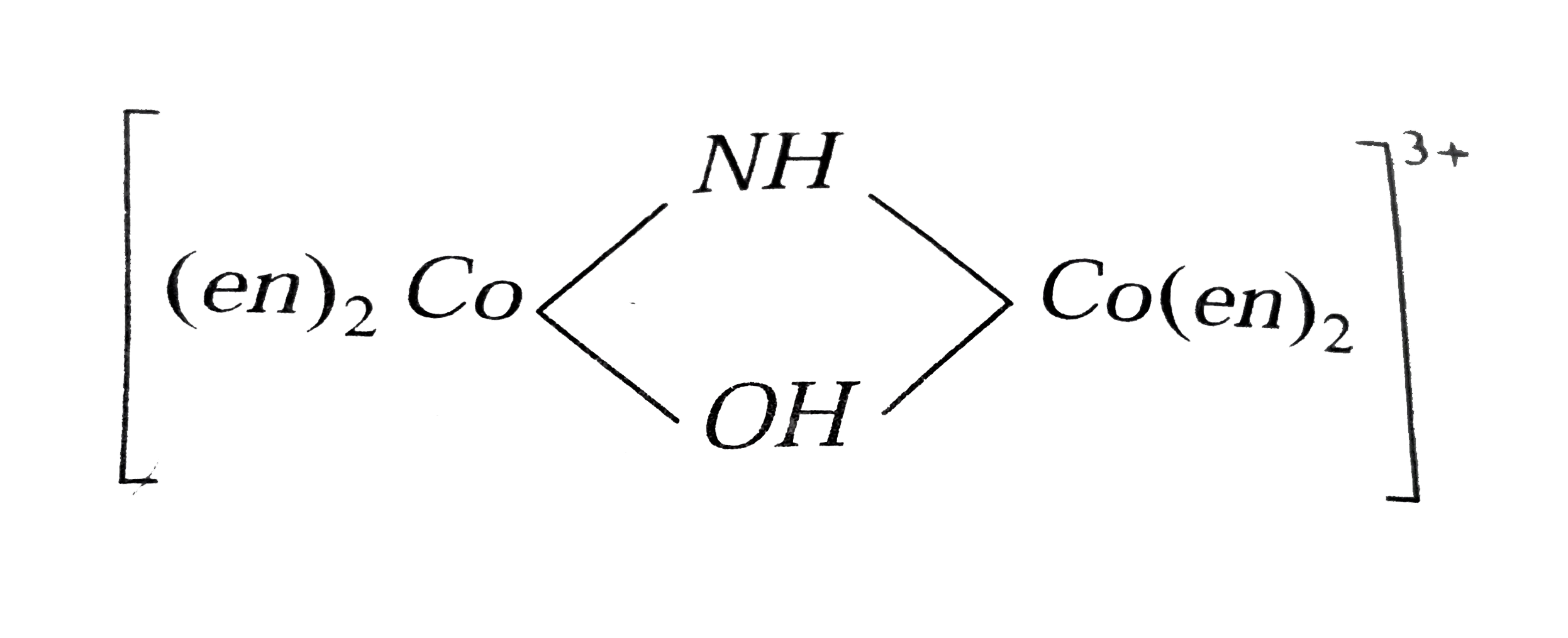Assertion :  is named as tetrakis ( ethylene diamine ) μ- hydroxo - imido dicobalt (III) ion.
is named as tetrakis ( ethylene diamine ) μ- hydroxo - imido dicobalt (III) ion.
Reason : In naming polynuclear complexes i.e., containing two or more metal atoms joined by bridging ligands, the word μ is add with hyphen before the name of such ligands.
If both assertion and reason are true and the reason is the correct explanation of the asserion.
If both assertion and reason are true but reason is not the correct explanation of the assrtion.
if assertion is true but reason is false.
if assertion is false but reason is true
The correct Answer is:D
Assertion is false but reason is true. is named as tetrakis ( ethylene diamine)- μ - hydroxo −μ− imido dicobal (III) ion. For more than one bridging group the word μ is repeated before each bridging group.
is named as tetrakis ( ethylene diamine)- μ - hydroxo −μ− imido dicobal (III) ion. For more than one bridging group the word μ is repeated before each bridging group.
Topper's Solved these Questions
- COORDINATION CHEMISTRYBOOK - ERRORLESS CHAPTER - COORDINATION CHEMISTRYEXERCISE - ORDINARY THINKING Objective Questions (Isomerism and Magnetic properties)
86 Videos
- COORDINATION CHEMISTRYBOOK - ERRORLESS CHAPTER - COORDINATION CHEMISTRYEXERCISE - ORDINARY THINKING Objective Questions (HYBRIDISATION AND GEOMETRY)
53 Videos
- COORDINATION CHEMISTRYBOOK - ERRORLESS CHAPTER - COORDINATION CHEMISTRYEXERCISE - JEE(ADVANCED 2018 MORE THAN ONE CHOICE CORRECT ANSWER
1 Videos
- CLASSIFICATION OF ELEMENTS AND PERIODIC PROPERTIES BOOK - ERRORLESS CHAPTER - CLASSIFICATION OF ELEMENTS AND PERIODIC PROPERTIES EXERCISE - JEE Section Matrix Match type questions
2 Videos
- D & P-BLOCK ELEMENTSBOOK - ERRORLESS CHAPTER - D & P-BLOCK ELEMENTSEXERCISE - JEE Section (Numeric answer type questions)
2 Videos
Similar Questions
The IUPAC name of [Co(H2NCH2CH2NH2)2(NO2)NO5 is bis(enthane-1,2-diamine) dinitrito-N-cobalt(III) nitrate.It follows the following rules that.
(a)Cation is named first followed by anion.
(b) Ligands are named in an alphabetical order before the name of the central atom/ion.
( c)Name of anionic ligands end in "o" (ex.chlorido) those of neutral (and if cation) ligands are the same except aqua for H2O, ammine for NH3 etc.
(d)Prefixes mono,di,tri,etc.are used to indicate the number of individual ligand.When the name of the ligands include a numerical prefix, then terms bis, tris, tetrakis are used.
(e)Oxidation state of the metal is indicated by Roman numeral in parenthesis.
(f) For cationic and neutral complexes, the metal is named same as the element and for anionic complex, the name of metal ends with suffix-ate.For some metals, the Latin names are used in the complex anions , e.g., ferrate for Fe, argentate for silver etc.
The IUPAC name of Fe4[Fe(CN)6]3 is :
View SolutionThe IUPAC name of [Co(H2NCH2CH2NH2)2(NO2)NO5 is bis(enthane-1,2-diamine) dinitrito-N-cobalt(III) nitrate.It follows the following rules that.
(a)Cation is named first followed by anion.
(b) Ligands are named in an alphabetical order before the name of the central atom/ion.
( c)Name of anionic ligands end in "o" (ex.chlorido) those of neutral (and if cation) ligands are the same except aqua for H2O, ammine for NH3 etc.
(d)Prefixes mono,di,tri,etc.are used to indicate the number of individual ligand.When the name of the ligands include a numerical prefix, then terms bis, tris, tetrakis are used.
(e)Oxidation state of the metal is indicated by Roman numeral in parenthesis.
(f) For cationic and neutral complexes, the metal is named same as the element and for anionic complex, the name of metal ends with suffix-ate.For some metals, the Latin names are used in the complex anions , e.g., ferrate for Fe, argentate for silver etc.
The IUPAC name of the coordination compound [NICl(NO2)(PPh3)2] is :
View Solution
Knowledge Check
Assertion :
 is named as tetrakis (ethylene- diammine) μ−hydroxo−μ−imido dicobalt (III) ion.
is named as tetrakis (ethylene- diammine) μ−hydroxo−μ−imido dicobalt (III) ion.
Reason : In naming polynuclear complexes i.e., containing two or more metal atoms joined by bridging ligands, the word μ is added with hyphen before the nane of such ligands.AIf both assertion and reason are true and reason is the correct explanation of assertionBIf both assertion and reason are true but reason is not the correct explanation of assertionCIf assertion is true but reason is falseDIf both assertion and reason are false.Assertion : The name of the complex [Co(NH3)6]Cl3 is hexamminecobalt (III) chloride.
Reason. When a prefix like hexa ends in 'a' and the ligand like 'ammonia' starts with 'a', only one 'a' is retained.AIf both assertion and reason are true, but reason is not the true explanation of the assertionBIf both assertion and reason are true, but reason is not the true explanation of the assertionCIf assertion is true, but reason is falseDIf both assertion and reason are falseThe IUPAC name of [Co(H2NCH2CH2NH2)2(NO2)NO5 is bis(enthane-1,2-diamine) dinitrito-N-cobalt(III) nitrate.It follows the following rules that.
(a)Cation is named first followed by anion.
(b) Ligands are named in an alphabetical order before the name of the central atom/ion.
( c)Name of anionic ligands end in "o" (ex.chlorido) those of neutral (and if cation) ligands are the same except aqua for H2O, ammine for NH3 etc.
(d)Prefixes mono,di,tri,etc.are used to indicate the number of individual ligand.When the name of the ligands include a numerical prefix, then terms bis, tris, tetrakis are used.
(e)Oxidation state of the metal is indicated by Roman numeral in parenthesis.
(f) For cationic and neutral complexes, the metal is named same as the element and for anionic complex, the name of metal ends with suffix-ate.For some metals, the Latin names are used in the complex anions , e.g., ferrate for Fe, argentate for silver etc.
The correct IUPAC name of the coordination compound [Pt(NH3)2Cl(NH2CH3)] is :ADiamminechlorido (methylamine ) plantinate (II) chlorideBChloridodiamine (methylamine)platinum (II) chlorideCDiamminechlorido (methylamine)platinum (II) chlorideDDiammine(methylamine) chloridoplatinum (II) chloride
Read the passage given below and answer the following questions :
The crystal field theory (CFT) is an electrostatic model which considers the metal-ligand bond to be ionic arising purely from electrostatic interactions between the metal ion and the ligand. Ligands are treated as point charges in case of anions or dipoles in case of neutral molecules. The five d orbitals in an isolated gaseous metal atom/ion have same energy, i.e., they are degenerate. This degeneracy is maintained if a spherically symmetrical field of negative charges surrounds the metal atom/ ion. However, when this negative field is due to ligands (either anions or the negative ends of dipolar molecules like NH3 and H2O) in a complex, it becomes asymmetrical and the degeneracy of the d orbitals is lifted. It results in splitting of the d orbitals.
A chelating agent has two or more than two donor atoms to bind to a single metal ion. Which of the following is not a chelating agent ?
View SolutionValence bond theory for bonding in transition metal complexes was developed by Pauling. From the valence bond point of view, formation of a complex involves reaction between Lewis bases (ligands) and a Lewis acid (metal atom or metal ion) with the formation of coordination covalent (or dative) bonds between them. The model utilizes hybridization of metal s, p and d valence orbitals to account for the observed structures and magnetic properies of complexes.
Valence bond theory is able to deal satisfactorily with many stereo chemical and magnetic properies but is has nothing to say about electronic spectra or the reason for the kinetic inertness of chromium (III) and low spin cobalt (III) octahedral complexes. To understand this and more other features of transition metal we must turn to other theories like crystal field theory etc.
Pure crystal field theory assumes that the only interaction between the metal ion and the ligands is an electrostatic or ionic one with the ligands being regarded as negative point charges. This theory is quite successful in interpreting many important properties of complexes.
The hybridization of [NiCl2(PPh3)2] and [NiCl2.(Pme3)2] are respectively (consider PPh3 a bulkier ligand than Pme3) :
View SolutionValence bond theory for bonding in transition metal complexes was developed by Pauling. From the valence bond point of view, formation of a complex involves reaction between Lewis bases (ligands) and a Lewis acid (metal atom or metal ion) with the formation of coordination covalent (or dative) bonds between them. The model utilizes hybridization of metal s, p and d valence orbitals to account for the observed structures and magnetic properies of complexes.
Valence bond theory is able to deal satisfactorily with many stereo chemical and magnetic properies but is has nothing to say about electronic spectra or the reason for the kinetic inertness of chromium (III) and low spin cobalt (III) octahedral complexes. To understand this and more other features of transition metal we must turn to other theories like crystal field theory etc.
Pure crystal field theory assumes that the only interaction between the metal ion and the ligands is an electrostatic or ionic one with the ligands being regarded as negative point charges. This theory is quite successful in interpreting many important properties of complexes.
The hybridization of [NiCl2(PPh3)2] and [NiCl2.(Pme3)2] are respectively (consider PPh3 a bulkier ligand than Pme3) :
View SolutionValence bond theory for bonding in transition metal complexes was developed by Pauling. From the valence bond point of view, formation of a complex involves reaction between Lewis bases (ligands) and a Lewis acid (metal atom or metal ion) with the formation of coordination covalent (or dative) bonds between them. The model utilizes hybridization of metal s, p and d valence orbitals to account for the observed structures and magnetic properies of complexes.
Valence bond theory is able to deal satisfactorily with many stereo chemical and magnetic properies but is has nothing to say about electronic spectra or the reason for the kinetic inertness of chromium (III) and low spin cobalt (III) octahedral complexes. To understand this and more other features of transition metal we must turn to other theories like crystal field theory etc.
Pure crystal field theory assumes that the only interaction between the metal ion and the ligands is an electrostatic or ionic one with the ligands being regarded as negative point charges. This theory is quite successful in interpreting many important properties of complexes.
Which of the following is correct for the complex [Ti(H2O)6]3+ ?
View SolutionValence bond theory for bonding in transition metal complexes was developed by Pauling. From the valence bond point of view, formation of a complex involves reaction between Lewis bases (ligands) and a Lewis acid (metal atom or metal ion) with the formation of coordination covalent (or dative) bonds between them. The model utilizes hybridization of metal s, p and d valence orbitals to account for the observed structures and magnetic properies of complexes.
Valence bond theory is able to deal satisfactorily with many stereo chemical and magnetic properies but is has nothing to say about electronic spectra or the reason for the kinetic inertness of chromium (III) and low spin cobalt (III) octahedral complexes. To understand this and more other features of transition metal we must turn to other theories like crystal field theory etc.
Pure crystal field theory assumes that the only interaction between the metal ion and the ligands is an electrostatic or ionic one with the ligands being regarded as negative point charges. This theory is quite successful in interpreting many important properties of complexes.
Which of the following is correct for the complex [Ti(H2O)6]3+ ?
View Solution
